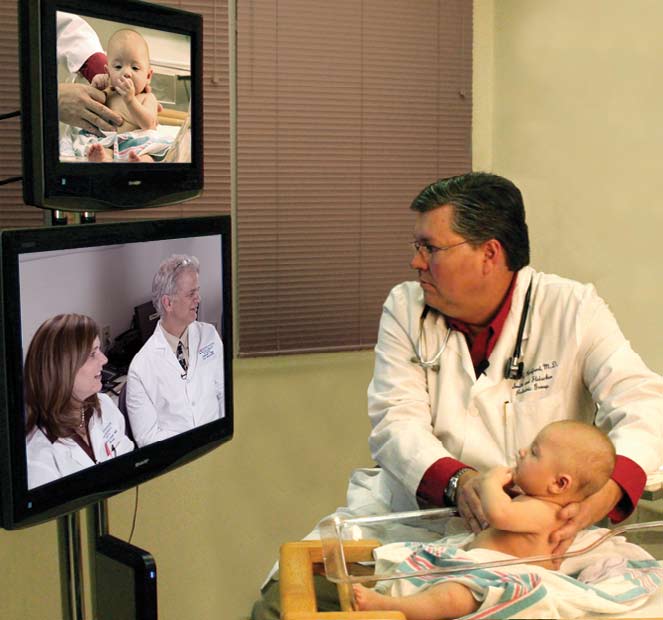Doctors at rural medical centers employ advanced videoconferencing technologies to access specialists who can help determine if a distressed newborn must be transported to a more advanced, but distant facility. Here, John Radford, M.D., a pediatrician at Adena Regional Medical Center, confers with Drs. Brown and Welty at Nationwide Children’s Hospital in Columbus.
Stacie Traylor delivered her tiny baby five weeks prematurely because of complications from gestational diabetes. Concerned doctors at Adena Regional Medical Center in Chillicothe, Ohio, informed Stacie that little Emilie had suffered a collapsed lung. They were considering moving Emilie 45 miles north to Nationwide Children’s Hospital in Columbus, where top neonatal specialists could treat her.
The doctors reconsidered the move and chose a different, more innovative approach to caring for Emilie. Through a pilot project with the Ohio Supercomputer Center, both hospitals had positioned sophisticated cameras and monitors in their nursery facilities and established a high-definition video connection through the fiber-optic channels of the Broadband Ohio Network. With the equipment in place, the specialists observed sharp, colorful video of the baby and consulted with her Adena doctors, ultimately determining that Emilie could safely be treated in Chillicothe, near her loving, worried parents.
“Telemedicine dramatically increases the care of our youngest patients,” said Dr. John Fortney, medical director for Adena Health System. “If we’re looking for help with a diagnosis, someone from Children’s— whether it’s a neonatologist or a sub-specialist, such as a pediatric cardiologist — will see the patient and speak to the attending physician in real time.
“Before, information was relayed by telephone, which meant it was subject to interpretation,” he said. “With high-definition videoconferencing, specialists can make a more thorough evaluation.”
Adena Regional Medical Center was selected for the pilot project because the hospital sends more pediatric patients to Nationwide Children’s than any other outside of the Columbus metropolitan area.
In their first year of operation with telemedicine, physicians were able to make quicker and more accurate clinical assessments via videoconferencing, especially regarding the need to transfer these critical-care newborns. The number of neonatal transports from Chillicothe, which cost thousands of dollars for each trip, has been reduced to half since the network consultations were introduced.
“If a baby needs to be moved to our facility, doctors have seen the child, reviewed their diagnostic images and can prepare for the infant’s care as soon as he or she arrives,” said Dr. Stephen Welty, chief of neonatology, Nationwide Children’s Hospital. “Just as importantly, we also use this as a tool to determine if a baby doesn’t need to be transferred. Then, the child can stay with family and avoid unnecessary stress.”
In the successful wake of the Adena project, engineers at the Ohio Supercomputer Center are working with doctors at Nationwide Children’s to expand the neonatal program to rural medical facilities in Portsmouth, Zanesville, Findlay and Marietta. OSC engineers for several years have been playing a major role in the deployment of high-definition videoconferencing systems, in areas such as education, health care, judicial courts and entertainment. In addition to the neonatal project, OSC has conducted studies of HDVC usability and reliability at two university game research and design labs, an organ-transplant services facility and a renowned music school.
These advances coincide with a growing national trend toward universal access to telemedicine. Recently, the Federal Communications Commission’s Rural Health Care Pilot Program awarded $417 million to 69 regional network projects around the nation to “significantly increase access to acute, primary and preventative health care in rural America.” Three of those projects provide high-speed connections to health care facilities in nearly half of Ohio’s 88 counties.
These regional networks will link to the Broadband Ohio Network backbone to transport intra-state data traffic and connect with Internet2, the primary national research and education network in the country.
“Broadband deployment is one of the Commission’s top priorities — particularly in rural America,” the FCC said in a release. “And nowhere is the need for broadband greater than in rural health care, where isolated clinics can save lives by using advanced communications technology to tap the expertise of modern urban medical centers.”
Once these high-tech health care delivery systems are in operation, heart-warming success stories — such as little Emilie’s — should be more commonplace.
--
Project leads: Nationwide Children’s Hospital, Adena Regional Medical Center & OSC
Research title: Medical collaboration network demonstration project on OSCnet
Funding source: American Distance Education Consortium & Ohio Board of Regents
